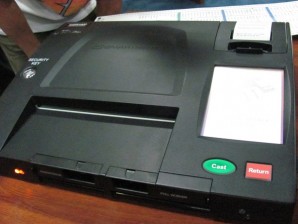PCOS digital lines no proof of fraud, say techies
The “digital lines” that appeared in the scanned ballot images in the 2013 elections have been attributed to dust, ink stains, and hardware damage to the sensor used for scanning, based on the findings of experts tapped by the Commission on Elections (Comelec).
Some of the digital lines that appeared in the ballot images scanned by the precinct count optical scan (PCOS) machines had bisected the ovals that voters had to shade, thereby affecting the accuracy of the counting of the votes.
But given the findings of the Technical Evaluation Committee (TEC) that looked into the issue, Sen. Aquilino Pimentel III said the digital lines could not be said to be part of a scheme to manipulate votes for certain candidates.
“It appears that the appearance of digital lines is not a manifestation to cheat or systematic mode of cheating, because the cause of the digital lines is not high tech—dirt, dust particles—not software or code,” Pimentel, chair of the Joint Congressional Oversight Committee on the Automated Elections System, told reporters.
Nevertheless, he said there was a need for the Comelec to ensure that the reasons for the appearance of the digital lines would be addressed before the 2016 polls, especially to prevent unscrupulous individuals from exploiting these to sabotage and degrade the counting of votes.
The digital lines could still have a significant effect in some races, he said.
“In close contests, in close elections, it can affect the proclamation of the winner,” he said.
At the hearing of the joint committee yesterday, TEC chair and engineer Peter Banzon, who is also from the Department of Science and Technology, said the two major causes for the digital lines are foreign matter contamination and hardware damage on the contact image sensor.
Banzon explained that all of the digital lines found in the scanned ballot images were vertical, and were of varying widths. Some of the lines were found on the front and back images of the ballot and some appeared more than once on each page.
Not all of the lines affected the counting of votes. Whether the lines affected the count depended on their thickness.
In the case of foreign matter contamination, these could be dust, rust, ink stains and even small objects such as bits of paper, staple wire and insect body parts.
Banzon explained that the digital lines are formed when dust blocks the optical path of the scanner. The scanner will think there is a mark on that location, and because the method has the paper sliding across the scanner, that mark will become a line.
The build-up of dust could be due to static electricity, which attracts dust. The length of the ballot as well as the humidity are also factors for increasing the presence of dust, he said.
Ink stains on the mylar used for scanning could also cause the digital lines, especially if the paper and ink used on the ballots are not of the proper specifications.
Since the PCOS has metal parts, these could also form rust particles that cause the digital lines.
As for hardware damage, Banzon said this was less common of an occurrence. The damage could be due to static electricity, an unstable power supply and normal aging of the machines.
Banzon also said that of the ballots in 383 precincts studied by Comelec for digital lines, 84 percent did not have these lines.
Of the ballots where the lines appeared, 94 percent had lines that did not touch the oval, so there was no effect on the ballot interpretation.
